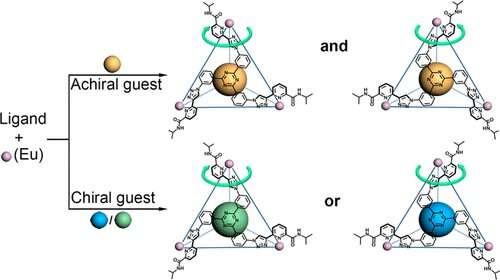Researchers achieve guest-driven self-assembly and chiral induction of photofunctional lanthanide tetrahedral cages

Chiral coordination cages have potential applications in enantioselective recognition, sensing and symmetric catalysis. In general, chiral coordination cages can be synthesized either by starting from enantiopure ligands/metal-organic precursors or post assembly resolution/modification with chiral auxiliaries. Due to the paucity of structures and their limited cavities, host-guest chemical properties of lanthanide-organic cages still need to be explored, especially based on noncovalent host-guest interaction, the stereoselective synthesis strategy of lanthanide-organic cages induced by chiral guest as template has not been reported.
In a study published in Journal of the American Chemical Society, the research group led by Prof. Sun Qingfu from Fujian Institute of Research on the Structure of Matter of the Chinese Academy of Sciences reported the guest-driven self-assembly and chiral induction of photofunctional lanthanide tetrahedral cages.
In previous work, the researchers found that interligand π-π stacking plays a crucial role in the formation of lanthanide-organic sandwich structures. On this basis, in this study, they achieved the template-controlled synthesis of lanthanide-organic tetrahedral cages by introducing extra electron-rich aromatic guest molecules to disrupt the π-π stacking effect between ligands.
The researchers obtained the single crystal structures of host-guest complexes of all eight achiral guests, precisely proved the interaction mechanism between the host and the guest, and quantitatively analyzed the inducing ability of different guests by nuclear magnetic resonance (NMR) titration.
Volume calculations based on the single-crystal structure demonstrated that the rich coordination configuration of lanthanide ions endows the lanthanide-organic tetrahedral cages with continuously tunable substrate-adaptive cavities.
Photochemical and photophysical performance tests showed that the noncovalent confinement of pyrene within the Eu4L4 cage not only suppressed its excimer emission but also facilitated effective host-guest energy transfer.
Furthermore, the researchers realized chiral induction on the lanthanide tetrahedral cages when enantiopure biphenol templates were used, giving rise to strongly circular-polarized luminescent Eu4L4 cages, with high dissymmetry factors of glum up to ±0.125, and achieved chiral transcription from small molecule point chirality to supramolecular topological chirality.
This study provides a new avenue for the synthesis of chiral lanthanide-organic cages, and for sensitized luminescence of lanthanide-organic architectures based on host-guest energy transfer.
More information: Shao-Jun Hu et al, Guest-Driven Self-Assembly and Chiral Induction of Photofunctional Lanthanide Tetrahedral Cages, Journal of the American Chemical Society (2022). DOI: 10.1021/jacs.2c00760
Journal information: Journal of the American Chemical Society
Provided by Chinese Academy of Sciences





















